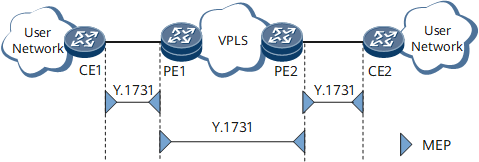Configuring Y.1731 Functions in VPLS Networking
This section describes how to configure Y.1731 functions including single-ended frame loss measurement, dual-ended frame loss measurement, one-way frame delay measurement, two-way frame delay measurement in VPLS networking.
Applicable Environment
The VPLS technology implements MP2MP VPN networking, and therefore there may be multiple PWs between devices in the same VSI. As shown in Figure 1, the PEs are connected through a VPLS network. To take accurate statistics about frame loss on one end of a PW or an AC in VPLS networking, the performance monitoring functions defined by Y.1731 can be used to monitor links.
Pre-configuration Tasks
Before configuring Y.1731 functions in VPLS networking, complete the tasks listed in Table 1.
Function |
Pre-configuration Task |
|---|---|
Configuring Y.1731 functions (single-ended frame loss measurement, dual-ended frame loss measurement, one-way frame delay measurement, and two-way frame delay measurement) for an AC in VPLS networking |
|
Configuring Y.1731 functions (single-ended frame loss measurement, dual-ended frame loss measurement, one-way frame delay measurement, and two-way frame delay measurement) for a PW in VPLS networking |
|
- Binding an MA to a VPLS Network
- Binding an MA to a VPLS network is a prerequisite for configuring single-ended frame loss measurement, dual-ended frame loss measurement, one-way frame delay measurement, or two-way frame delay measurement in VPLS networking.
- Configuring Single-ended Frame Loss Measurement in VPLS Networking
- In VPLS networking, the clock frequencies between the two ends are synchronized and CFM is enabled to monitor link connectivity. If the unidirectional delay measurement needs to be performed for a link, one-way frame delay measurement can be configured to monitor the quality of the link.
- Configuring Dual-ended Frame Loss Measurement in VPLS Networking
- In VPLS networking, CFM is enabled to monitor link connectivity. If accurate frame loss measurement needs to be performed for a link, dual-ended frame loss measurement can be configured to monitor the quality of the link.
- Configuring One-way Frame Delay Measurement in VPLS Networking
- In VPLS networking, the clock frequencies between the two ends are synchronized and CFM is enabled to monitor link connectivity. If the unidirectional delay measurement needs to be performed for a link, one-way frame delay measurement can be configured to monitor the quality of the link.
- Configuring Two-way Frame Delay Measurement in VPLS Networking
- In VPLS networking, if the clocks of the MEPs at both ends of a link are not synchronized and the requirement for delay measurement is not high, two-way frame delay measurement can be configured for the link.
- Configuring Single-ended SLM in VPLS Networking
- To perform packet loss performance measurement on a point-to-multipoint or multipoint-to-multipoint links, deploy single-ended synthetic loss measurement (SLM) to monitor the link quality.
- Configuring the ETH-Test Function for a VPLS Connection
- The ETH-test function is short for Ethernet test signal. ETH-test instances are performed for a unidirectional on-demand service or during an on-demand-service interruption to calculate parameters, including the maximum bandwidth, frame loss ratio, and bit error rate.
- Configuring AIS
- Configuring AIS prohibits a MEP in an MD of a higher level from sending the same alarm as that sent by a MEP in an MD of a lower level to the NMS.
